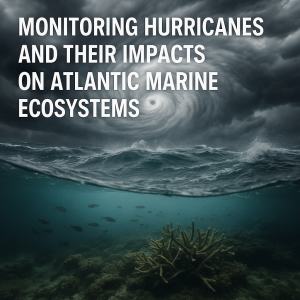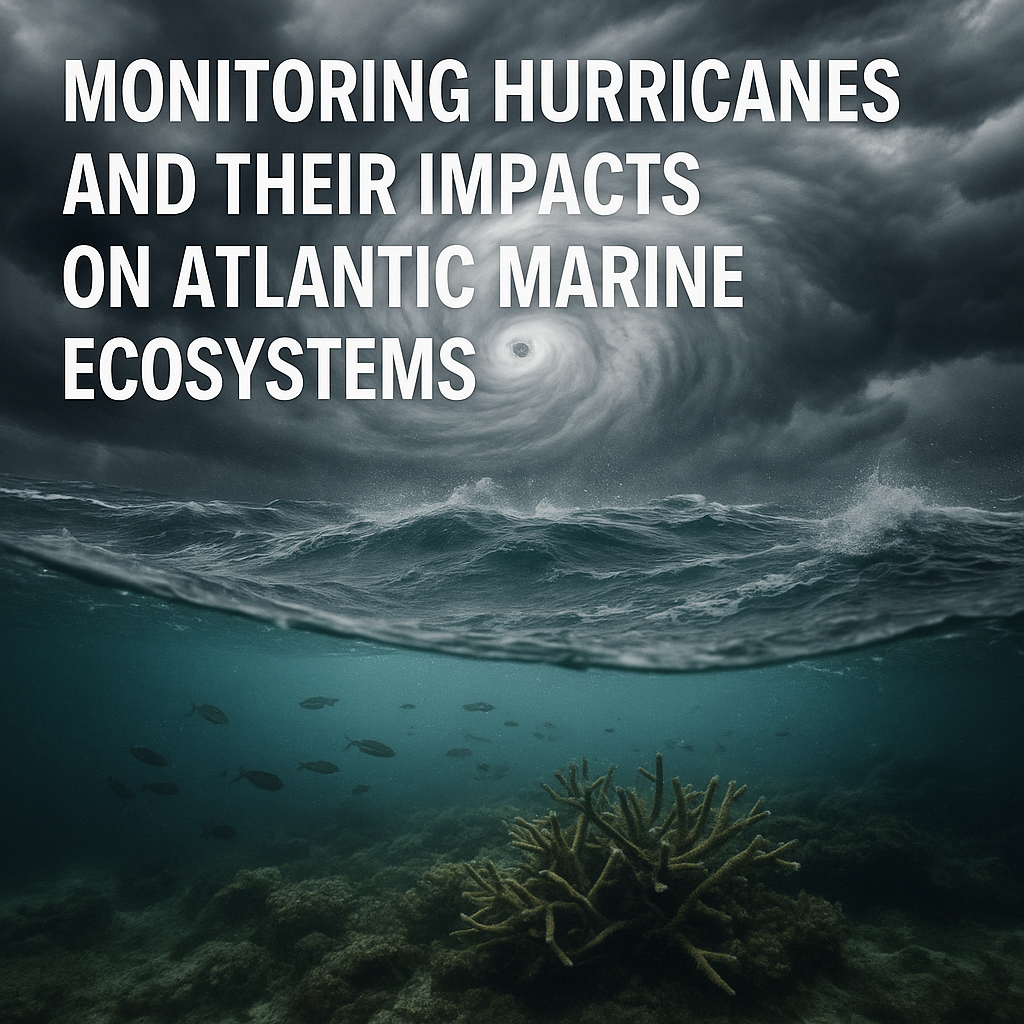Explore how hurricanes impact Atlantic marine ecosystems and discover the latest monitoring technologies, real-world case studies, and future resilience strategies.
Why Monitoring Hurricanes Matters in Maritime and Environmental Sectors
 In the Atlantic Ocean, hurricanes are more than just dangerous weather systems. They are powerful natural forces that can reshape coastlines, devastate communities, and disrupt marine ecosystems. These tropical cyclones—which draw their energy from warm ocean waters—are intensifying in both frequency and strength due to climate change. According to the National Oceanic and Atmospheric Administration (NOAA), the Atlantic hurricane season has become longer and more intense over the past two decades, placing both human lives and marine biodiversity at increased risk (NOAA, 2024).
In the Atlantic Ocean, hurricanes are more than just dangerous weather systems. They are powerful natural forces that can reshape coastlines, devastate communities, and disrupt marine ecosystems. These tropical cyclones—which draw their energy from warm ocean waters—are intensifying in both frequency and strength due to climate change. According to the National Oceanic and Atmospheric Administration (NOAA), the Atlantic hurricane season has become longer and more intense over the past two decades, placing both human lives and marine biodiversity at increased risk (NOAA, 2024).
For maritime professionals, the stakes are high. Ports, shipping routes, offshore energy infrastructure, and fisheries all operate in delicate balance with the surrounding environment. When a Category 4 hurricane makes landfall, it doesn’t just batter coastal towns—it stirs sediments, disrupts ocean currents, and tears apart coral reefs and seagrass beds that serve as nurseries for fish and other marine species.
In this context, monitoring hurricanes and understanding their ecological impacts is critical for effective maritime planning, emergency response, and long-term environmental resilience.
How Hurricanes Form and Affect Marine Environments
Hurricanes begin as tropical disturbances near the equator. As warm, moist air rises from the ocean’s surface, it creates a low-pressure system. When sea surface temperatures are above 26.5°C (79.7°F) and wind shear is low, these disturbances can evolve into organized cyclones.
When a hurricane passes through an oceanic region, it churns up the water column in a process called vertical mixing. This can:
- Cool the surface temperature, disrupting thermal stratification
- Bring nutrients from the deep to surface layers, creating algal blooms
- Reduce oxygen levels due to decomposing biomass
In areas such as the Caribbean Sea, Gulf of Mexico, and West African coasts, hurricanes have caused significant damage to coral reefs, mangroves, and estuarine habitats. A 2023 study in the Marine Pollution Bulletin showed that post-hurricane sedimentation smothered coral polyps in several reefs off the coast of Belize, leading to bleaching and long-term degradation.
Technologies and Methods Used to Monitor Atlantic Hurricanes
The science of hurricane tracking has advanced rapidly in recent years, combining oceanographic sensors, satellite imaging, AI, and autonomous marine systems. Here are some of the most impactful tools:
Satellite Remote Sensing
Satellites operated by NASA, NOAA, and ESA provide real-time data on wind speeds, rainfall, and sea surface temperatures. The Sentinel-3 satellite from the European Space Agency includes ocean color monitoring, useful for detecting post-hurricane algal blooms.
ARGO Floats and Ocean Drifters
These autonomous instruments measure temperature, salinity, and ocean currents at various depths. When deployed in hurricane-prone regions, they help scientists analyze how storms affect subsurface layers and biological productivity.
Wave Gliders and Unmanned Surface Vessels (USVs)
Manufactured by companies like Liquid Robotics and utilized by NOAA, these surface drones can enter hurricane zones to record data that would be dangerous for manned vessels to collect. They have been instrumental in understanding how hurricanes fuel themselves using upper-ocean heat content.
Acoustic Doppler Current Profilers (ADCPs)
Deployed from anchored buoys or research vessels, these instruments monitor current velocities throughout the water column, allowing scientists to model how hurricanes redistribute nutrients and sediments.
MarineTraffic and Inmarsat Systems
Real-time tracking of vessels through AIS (Automatic Identification Systems) enables port authorities and shipping companies to reroute vessels and avoid hurricane damage. Inmarsat’s Fleet Safety and Fleet Secure platforms have also integrated weather alerts for commercial fleets.
Case Studies of Hurricane Impact on Atlantic Marine Ecosystems
Hurricane Dorian (2019) – Bahamas
Dorian caused widespread damage to the coral reefs surrounding the Abaco Islands. A post-event study by the Perry Institute for Marine Science found that reef fish biomass declined by 30% in the months following the storm. Researchers attributed this not only to physical damage but also to disrupted trophic interactions and migration patterns.
Hurricane Maria (2017) – Puerto Rico
According to Marine Ecology Progress Series, seagrass beds in Puerto Rico’s coastal lagoons were uprooted or buried under sand, affecting turtle feeding grounds and juvenile fish populations. The event highlighted the vulnerability of blue carbon ecosystems to extreme weather.
Hurricane Ida (2021) – U.S. Gulf Coast
While much of the coverage focused on infrastructure, NOAA’s post-event ecological monitoring revealed significant hypoxia in offshore zones. The hurricane had stirred up bottom sediments, releasing nutrients that led to oxygen-depleting blooms, affecting shrimp and crab fisheries.
Challenges in Monitoring and Managing Hurricane Impacts
Despite advancements, several gaps remain:
Data Gaps in Deep Ocean Zones
While coastal monitoring is robust, deep-sea ecosystems in the Atlantic’s abyssal plains are rarely studied after hurricanes. These areas may be affected by deep-sea turbidity currents and disrupted carbon cycling.
Limited Resources in Developing Nations
Atlantic-facing countries in West Africa and the Caribbean often lack funding and technical capacity for robust hurricane-ecosystem monitoring. According to UNCTAD, this impedes resilience planning and insurance assessments (UNCTAD, 2023).
Difficulty in Isolating Variables
It is hard to distinguish hurricane impacts from other environmental stressors like ocean acidification, overfishing, or oil pollution. Long-term datasets and integrated modeling are needed to establish clearer cause-effect relationships.
Solutions and Resilience Strategies
Ecosystem-Based Adaptation (EbA)
Projects in the Dominican Republic and Cuba are restoring mangroves and coral reefs to act as natural storm barriers. Supported by the Global Environment Facility (GEF), these projects offer both ecological and protective value.
Real-Time Coastal Observing Systems
Countries like the U.S. and Canada have expanded their Integrated Ocean Observing Systems (IOOS) and SmartBay platforms to provide real-time updates to port authorities, fishermen, and maritime logisticians.
Port and Infrastructure Resilience Planning
According to the International Association of Ports and Harbors (IAPH), more ports are incorporating hurricane simulations into their operational continuity planning. Lloyd’s Register has also published resilience guidelines for offshore energy operators.
Education and Early Warning Systems
Massachusetts Maritime Academy and Caribbean universities are integrating hurricane science and marine ecology into maritime training. Empowering local communities with early warning apps, radio alerts, and AI-enhanced predictions is another game-changer.
Future Outlook
With global warming predicted to further intensify Atlantic hurricanes, the intersection between meteorology and marine ecology will grow in importance. Artificial Intelligence (AI), machine learning, and real-time ocean forecasting models are expected to play greater roles. A recent Springer publication estimated that storm-induced marine ecosystem shifts could become permanent in 25% of Atlantic coral reef systems by 2040 if current trends persist.
On the brighter side, collaborations like the UN Decade of Ocean Science for Sustainable Development (2021–2030) are bringing together researchers, maritime professionals, and policymakers to co-design resilient blue economies.
Frequently Asked Questions
What months are most active for Atlantic hurricanes? The Atlantic hurricane season runs from June 1 to November 30, with peak activity in August and September.
How do hurricanes affect coral reefs? They cause physical breakage, increase sedimentation, and reduce water clarity, leading to coral bleaching and reduced photosynthesis.
Can hurricanes have positive effects on marine ecosystems? In some cases, vertical mixing can bring nutrients to the surface and fuel short-term productivity. However, the long-term impacts are often negative.
What technologies are used to monitor hurricanes at sea? Satellites, ARGO floats, wave gliders, acoustic sensors, and real-time AIS ship-tracking systems are commonly used.
How do ports prepare for hurricane season? Ports may suspend operations, relocate vessels, reinforce infrastructure, and activate continuity plans guided by IMO and IAPH guidelines.
Are hurricane impacts worse due to climate change? Yes. Warmer oceans provide more energy, increasing storm intensity, duration, and rainfall, according to the Intergovernmental Panel on Climate Change (IPCC).
What role do shipping companies play in monitoring? Firms like Maersk, CMA CGM, and NYK use onboard sensors and collaborate with maritime agencies to share real-time ocean data during storm events.
Conclusion
Monitoring hurricanes and their impacts on Atlantic marine ecosystems is no longer a seasonal concern—it’s a year-round imperative. From coral reefs in the Caribbean to seagrass beds along the U.S. East Coast, the marine environment is being reshaped by intensifying storms. Fortunately, advancements in ocean monitoring, AI-driven forecasting, and collaborative resilience projects are giving us the tools to act proactively.
For maritime professionals, environmental scientists, and port authorities alike, staying informed and investing in ecosystem-aware strategies will be critical. After all, the health of the Atlantic is tied to the health of our global economy, our climate, and our future.
References
- NOAA. (2024). Atlantic Hurricane Season Outlook. https://www.noaa.gov
- UNCTAD. (2023). Climate Resilience in Coastal Economies. https://unctad.org
- Marine Pollution Bulletin. (2023). Impact of Hurricanes on Coral Reefs in Belize. Elsevier
- Marine Ecology Progress Series. (2021). Seagrass Damage in Puerto Rico. Inter-Research
- Perry Institute for Marine Science. (2020). Post-Dorian Reef Monitoring Report.
- European Space Agency (ESA). Sentinel Satellite Missions. https://www.esa.int
- The Royal Institution of Naval Architects (RINA). Hurricane-Resilient Marine Structures. https://www.rina.org.uk
- Inmarsat. (2023). Fleet Safety Enhancements. https://www.inmarsat.com
- Springer Nature. (2022). Climate Trends and Marine Ecosystems. Springer
- Lloyd’s Register. (2022). Offshore Infrastructure Resilience Standards. https://www.lr.org
- IAPH. (2023). Port Resilience Planning Toolkit. https://www.iaphworldports.org

